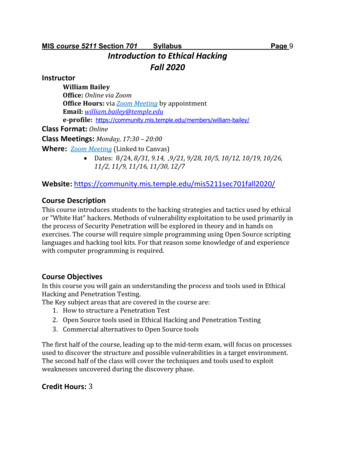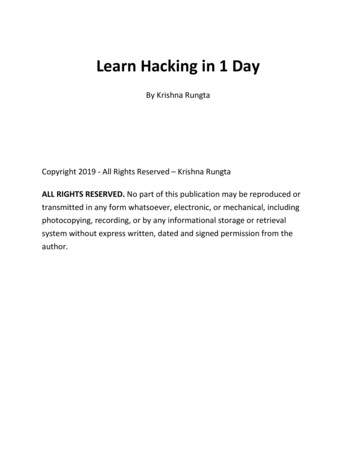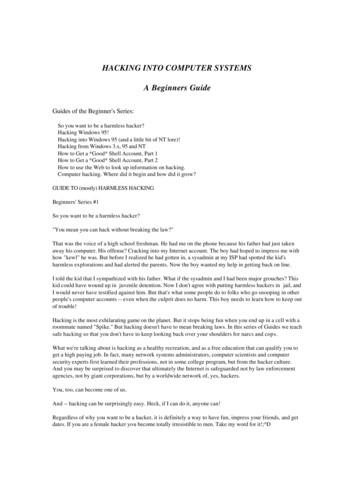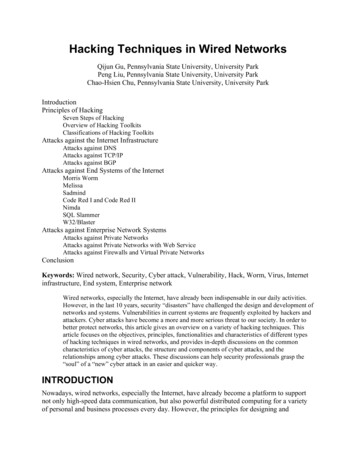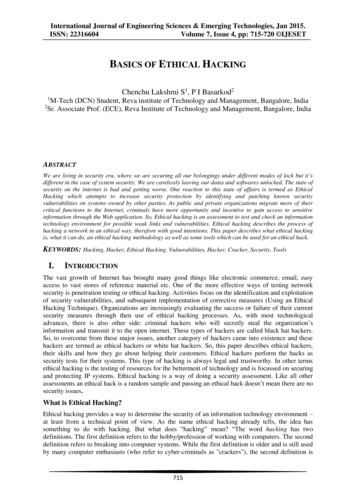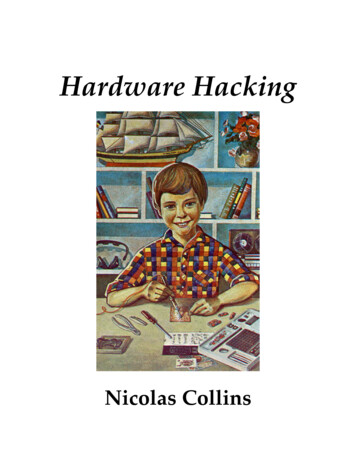
Transcription
Hardware HackingNicolas Collins
Nicolas CollinsHardware Hacking
rev. 2.1, May 2004Copyright Nicolas Collins 2003, 2004.No reproduction without permission.Contact: ncollins@artic.edu
Hardware Hacking 1ContentsPart I: StartingIntroduction -- 4Chapter 1: Getting Started -- 7Tools and materials needed.Chapter 2: The Seven Basic Rules of Hacking -- 9General advice.Part II: ListeningChapter 3: Circuit Sniffing -- 12Using radios and coils to eavesdrop on hidden electromagnetic music.Chapter 4: In/Out -- 15Speaker as microphone, microphone as speaker – the symmetry of it all.Chapter 5: The Celebrated Jumping Speaker of Bowers County -- 17Twitching loudspeakers with batteries.Chapter 6: How to Solder -- 19An essential skill.Chapter 7: How to Make a Contact Mike -- 21Using Piezo disks to pick up tiny sounds.Chapter 8: Turn You Tiny Wall Into a Speaker -- 27Resonating objects with Piezo disks, transformers and motors.Chapter 9: Tape Heads -- 30Playing credit cards with hand-held tape heads.Chapter 10: A Simple Air Mike -- 33Cheap condenser mike elements make great microphones.Part III: TouchingChapter 11: Laying of Hands -- 38Transforming a portable radio into a synthesizer by making your fleshpart of the circuit.Chapter 12: Tickle the Clock -- 41Finding the clock circuit in toys.Chapter 13: Hack the Clock -- 44Changing the clock speed for cool new noises.Chapter 14: Ohm’s Law for Dummies -- 48How to understand resistors.Chapter 15: Beyond the Pot -- 50Photocells, pressure pads, and other ways to control and play your toy.Chapter 16: Switches -- 55How to understand different switches, and even make your own.Chapter 17: Jack, Batt & Pack -- 58Finishing touches: powering and packaging your hacked toy.
2 Nicolas CollinsPart IV: BuildingChapter 18: World’s Simplest Oscillator -- 64Six oscillators on a 20 cent chip, guaranteed to work.Chapter 19: From Breadboard to Circuit Board -- 72How to solder up your first homemade circuit.Chapter 20: More Oscillators -- 75Oscillators that modulate each other.Chapter 21: Even More Oscillators -- 79Dividers, feedback loops and instability; using oscillators as clocks fortoys.Chapter 22: On/Off -- 83Gating, ducking, tremolo and panning -- and extracting sounds fromremote controls.Chapter 23: Amplification and Distortion -- 91A simple circuit that goes from clean preamp to total distortion.Chapter 24: Analog to Digital Conversion, Sort of -- 94Modulating other audio sources with your oscillators.Part V: LookingChapter 25: Video Music/Music Video -- 98Translating video signals into sound, and hacking cheap camera circuits.Chapter 26: LCD Art -- 100Making animated modern daguerreotypes.Part VI: FinishingChapter 27: Mixers, Matrices and Processing -- 104Very simple, very cheap, very clean mixers, and ways of configuring lotsof circuits.Chapter 28: A Little Power Amplifier -- 108Cheap & simple amplifier.Chapter 29: Power Supplies -- 110If you must, here’s how to plug into the wall with minimal risk.AppendicesAppendix 1: Resources -- 116Where to find information and materials.Appendix 2: Inventory -- 118What you need to do the projects in this book.Appendix 3: The Rules of Hacking -- 122A recapitulation.
Hardware Hacking 3Part I:Starting
4 Nicolas CollinsIntroductionThis book teaches you how to tickle electronics. It is a guide to the creativetransformation of consumer electronic technology for alternative use. We live ina cut and paste world: Control-X and Control-V give us the freedom to rearrangewords, pictures, video and sound to transform any old thing into our new thingwith tremendous ease and power. But, by and large, this is also an “off-line”world, whose digital tools, as powerful as they might be, are more suitable topreparing texts, photo albums, movies and CDs in private, rather than on stage.These days most “live electronic music” seems to be hibernating, its tranquilcountenance only disturbed from time to time by the occasional, discrete click ofa mouse.My generation of composers came of age before the personal computer, at a timewhen electronic instruments were far too expensive for anyone but rock stars oruniversities, but whose building blocks (integrated circuits) were pretty cheapand almost understandable. A small, merry, if masochistic, band, we presumedto Do-It-Ourselves. We delved into the arcane argot of engineering magazines,scratched our heads, swapped schematics, drank another beer, and cobbledtogether home-made circuits -- most of them eccentric and sloppy enough to givea “real” engineer dyspepsia. These folk electronic instruments became thecalling cards of a loose coalition of composers that emerged in the mid-1970s,after John Cage, David Tudor, and David Behrman, and before Oval, Moby, andMatmos. By the end of the 1970s the microcomputers that would eventuallyevolve into Apples and PCs had emerged from the primordial ooze of SiliconValley, and most of us hung up our soldering irons and started coding, but theodd circuit popped up from time to time, adding spice to the increasingly digitalmusical mix.Computers are wonderful, don’t get me wrong, but the usual interface -- anASCII keyboard and a mouse -- is awkward, and makes the act of performing apretty indirect activity -- like trying to hug a baby in an incubator. “Alternativecontrollers” (such as those made by STEIM and Buchla) are a step in the rightdirection, but sometimes it’s nice to reach out and touch a sound. This book liftsthe baby out of the basinet and drops her, naked and gurgling, into your waitingarms, begging to be tickled.The focus is on sound -- making performable instruments, aids to recording, andunusual noisemakers -- though some projects have a strong visual component aswell. No previous electronic experience is assumed, and the aim is to get youmaking things as quickly as possible, and keep you alive from start to finish.After learning basic soldering skills, you will make a variety of listening devices:acoustic microphones, contact mikes, coils for picking up stray electromagneticfields, tape heads. Then you will lay hands upon, and modify, cheap electronictoys and other found circuitry -- the heart and soul of hacking. You’ll build somecircuits from scratch: simple, robust oscillators that can be controlled through a
Hardware Hacking 5variety of means (light, touch, knobs, switches), and combined to create richelectronic textures at minimum cost and difficulty. With the confidence instilledby such a delicious din you can proceed with circuits to amplify, distort andotherwise mangle sound You can move on to some designs for linking soundwith visual material, and some convenient “glue” circuits, useful for puttingdisparate parts together for performance or recording. Finally, there are severalappendices to direct the reader to sources of supplies and further resources forinformation.In selecting the specific projects to include in this book I was guided by a handfulof fundamental assumptions and goals:1) To keep you alive. All the projects in this book are battery powered; noneplug into the potentially lethal voltage running through your walls. This makesthe early stages of unsupervised electronic play activity considerably safer, andless daunting for the beginner.2) To keep things simple. We work with a small number of very simple"axiomatic" circuits and concepts that can be combined with great permutationalrichness as you proceed and gain experience, but are easy to understand andquick to get running at the beginning. The point is to make cool sounds asquickly as possible.3) To keep things cheap. By limiting ourselves to a few core designs weminimize the quantity and cost of supplies needed to complete this book. Youdon't need a full electronics lab, just a soldering iron, a few hand tools, and about 50- worth of parts which you can easily obtain on-line. By focusing on toys andother simple consumer electronics we also minimize the threat of "catastrophicloss" in the early, unpredictable days of freestyle hacking:!a Microjammer setsyou back considerably less than a vintage Bass Balls.4) To keep it stupid. You will find here an absolute minimum of theory. Welearn to design by ear, not by eye, gazing at sophisticated test instruments orengineering texts. Ignorance is bliss, so enjoy it.5) To forgive and forget. There's no "right way" to hack. I will try to steer youaway from meltdowns, but have included designs that are robust, forgiving ofwiring errors, and accept a wide range of component substitutions if you don'thave the preferred part. Most of these circuits are starting points from whichyou can design many variations with no further help from me -- if you love ahack, let it run free.As a result of these koans, this is a distinctly non-standard introduction toelectronic engineering. Many of the typical subjects of a basic electronics course,such as the worrisomely vague transistor and the admittedly useful little thingcalled an op-amp, are left unmentioned. After turning over the last page, youwill emerge smarter, if weirder, than when you first opened the book. You willhave acquired some rare skills, and ones that are exceedingly useful in thepursuit of unusual sounds. You will have significant gaps in your knowledge,
6 Nicolas Collinsbut these gaps can be filled by a less structured stroll through resources easilyavailable in books and on-line (as described in Appendix 1.) And everythingelectronic you choose to do after this book will be easy, I promise. Why?Because you will be fearless. You will have the confidence to survey thosepresumptuous “No user serviceable parts inside!” labels and laugh. You will bea hacker.
Hardware Hacking 7Chapter 1: Getting StartedYou’ll need the following tools and materials to get started, and for most of theprojects in the bookTools: Soldering iron, finest point possible, 25-60 w. Not a soldering gun -- that’s forVoTech classes. Don’t get a cheap iron -- it makes it very frustrating to learnsoldering. Weller makes good ones that are reasonably priced and havereplaceable, interchangeable tips. Solder -- fine, rosin core -- not “acid-core” solder, that’s for plumbers. Diagonal cutters, small, for cutting wire and components down by thecircuit board. Wire strippers (unless you have the perfect gap between your front teeth)-- simple, adjustable manual kind for light-gauge wire. A set of jeweler’s screwdrivers (flat & philips) -- for opening toys with tinyscrews. A pair of scissors. A Swiss Army Knife. A small saw, utility knife, file, and drill will be useful when you start tohack toys and make cases for your circuits. A cheap digital multimeter -- test meter capable of reading resistance,voltage and current. Plastic electrical tape. Battery powered mini-amplifier with speaker. The cheapest one I’vefound is from Radio Shack (#277-1008, 11.99). You can also find weebitty guitar amps by Fender, Marshall, Dan Electro, etc. -- they look likelittle lunchboxes or the guitarist’s equivalent of shrunken heads. Theycost more than the Radio Shack amp, but some have the advantages of abigger speaker, a tone control and overdrive/distortion. It’s nice to have alot of gain available, so stay away from those small powered speakersthey sell for computers or Diskmen. Mini jumper cables with small alligator clips at each end, about 20 ofthem. A “Sharpie”-style fine-tipped permanent marker. Some small spring clamps or clothespins.Materials Lightweight insulated hookup wire, 18-22 gauge, 1 roll stranded, 1 rollsolid. Lightweight shielded audio hookup cable, single conductor plus shield. Assortment of standard value resistors, 1/8 or 1/4 watt. Sets are easilyand inexpensively available from Radio Shack or mail order/webretailers.
8 Nicolas Collins Assortment of capacitors, in the range of .001 - .1 uf monolithic ceramic ormetal film, and 1uf to 100uf electrolytic. These can be bought inassortments, or you can purchase a handful of each of a few differentvalues from across the full range, then replaced or supplemented asneeded as you go. 9 volt battery clips -- the things that snap onto the nipples at the end of a 9volt battery and terminate in lengths of wire. Get five or more. Assorted audio jacks and plugs to mate with other devices, i.e., youramplifier, jacks on toys, etc. Batteries for your amplifier, toys and circuits. Be a friend of theenvironment and invest in some rechargeable batteries.Other tools and materials will be introduced as needed. Basic shop tools -- suchas a small saw for metal and plastic, files, and an electric drill -- are useful whenyou start to work on packaging. A complete inventory of parts needed for all theprojects is included in Appendix 2.Your work space should be well-lit and ventilated. It should have a lot of tablespace; the table surface may be damaged by soldering, drilling and filing, so noChippendale please. You’ll need electrical power at the table for you solderingiron.
Hardware Hacking 9Chapter 2: The Seven Basic Rules of HackingRule #1: Never get into a conversation with anyone at Radio Shack.Rule #2: Don’t take apart anything that plugs directly into the wall.We will work almost exclusively with battery-powered circuitry. ACpowered things can kill you. AC adapters (“wall warts”) may be usedonly after you have displayed proper understanding of the differencebetween insulation and electrocution.Rule #3: It is easier to take something apart than put it back together.Objects taken apart are unlikely to function normally after they are putback together, no matter how careful you are. Consider replacement costbefore you open.Rule #4: Make notes of what you are doing as you go along, not after.Most wires look pretty much alike. As you take things apart make noteson which color wire goes to where on the circuit board, or to what jack,etc. Especially important are the wires that go to the battery. Likewise,note what you add as you add it, what you change as you change it.Rule #5: Avoid connecting the battery backwards.This can destroy many circuits.Rule #6: Many hacks are like butterflies: beautiful but short lived.Many hacks you perform, especially early in your career, may destroy thecircuit eventually. Accept this. If it sounds great, record it as soon aspossible, and make note of what you’ve done to the circuit so you can tryto recreate it later (see Rule #4.)Rule #7: In general try to avoid short circuits.Try to avoid making random connections between locations on a circuitboard using plain wire or a screwdriver blade. This can destroy a circuit -not always, but inevitably at the most inconvenient time.Additional rules will emerge from time to time throughout the book, and arerecapitulated in Appendix 3.
10 Nicolas Collins
Hardware Hacking 11Part II:Listening
12 Nicolas CollinsChapter 3: Circuit SniffingYou will need: A battery-powered AM radio. A battery-powered amp/speaker. An inductive telephone pickup coil or a loose electric guitar pickup. Optionally: a hundred feet of light-gauge insulated wire, an audio plugand 2 long pieces of wood.RadiosRadios make the inaudible audible. Unlike microphones and amplifiers, whichmerely make very quiet acoustic sounds much louder, radios pick upelectromagnetic waves that have no acoustic presence whatsoever and translatethem into signals that can be heard through a loudspeaker. Radios aremanufactured for listening to intentionally transmitted electromagnetic waves,i.e., those sent from radio stations. But they can also be used to sniff out othertypes of waves, such as those emitted by lightning, sun spots, Aurora Borealis,meteorites, camera flash units, computers, etc. Generally speaking AM radios(the cheaper the better) do a better job of picking up these “spurious” noises thanFM radios.Put batteries in the radio and turn it on; if it has a band switch set it initially toAM. Try moving it around various electrical appliances: fluorescent lights,electric motors, computers, portable CD players, cell phones, MP3 players (iPod)and remote controllers for RC planes and cars are especially noisy. Fire off acamera flash next to it. Experiment with tuning the radio to different stations,between them and to the dead bands at either end of the dial.As the FCC often warns you, certain electrical appliances can cause “radiointerference.” What this means is that, as a byproduct of whatever useful thingthey are doing, they emit lots spurious electromagnetic radiation in the samefrequency region as radio and TV broadcasts -- they whistle while they work. Asyou tune the radio it picks up different frequencies (mostly very high) ofelectromagnetic waves, shifts them down into the range of our hearing andamplifies them. Compared to radio stations these appliances put out very weaksignals -- the noise from a computer drops off rapidly as you move the radio afew feet away (hence the FCC advice on what to do.)If your radio has a FM band, try it as well. The technique of FM radiotransmission and reception is designed to minimize interference, but strongperiodic signals (like the clock frequency of a computer) can sometimes be tunedin.
Hardware Hacking 13CoilsAn alternate approach to picking up electromagnetic signals is to use a simplecoil of wire and an amplifier. A telephone pickup consists of yards of thincopper wire wrapped around an iron slug. Plugged into an amp this coil actslike a radio antenna for low frequencies. Stuck on a telephone receiver (or heldagainst any other loudspeaker) it picks up the electromagnetic field generated bythe voice coil of the speaker, allowing you to record your landlord makingunsavory threats.Plug the tap coil into the portable amp and repeat the same experiments we didwith the radio. Sometimes you will hear different types of sounds from the sameappliance. The coil is small enough that you can move it close in and to preciselocations, like a stethoscope. Open up a computer and pass it slowly over themotherboard, or over a laptop, and note the change in sound as you move fromthe CPU area to the RAM to the disk drive to the CDROM. Listen to smallmotors in fan, vibrators and toys; notice the change in pitch as you change themotor speed. Take a ride on the subway and listen to the motors and doors asyou come in and out of stations. Cozy up to a neon sign.Jérôme Noetinger, Andy Keep, Nathan Davis and others have made beautifuluse of this secret magnetic music.The stethoscope-like accuracy of the coil moving over a circuit board makes it auseful, non-destructive device for pinpointing the location of interesting soundsthat we can later tap off directly with a wires soldered to the board.If you move the coil near the speaker of your amplifier it will begin to feed backwith the coil that moves the speaker cone (see next chapter.) As with feedbackbetween a microphone and speaker, the pitch is affected by the distanceseparating the two parts, but here the pitch changes smoothly and linearly,without the odd jumps caused by the vagaries of acoustics, giving you aTheremin-like instrument. Try this with a full-size guitar amplifier for greaterrange.Speaking of guitars, you can use a guitar pickup in place of a telephone tap – aguitar pickup is just a coil of wire, wrapped around a magnet, inside anexpensive package. You can repeat the above experiments with a whole guitar inyour hands, but a loose pickup is handier. At repair shops you can sometimesbuy cheap the low-end pickups removed when better ones are installed. Jumpahead to Chapter 6 if you need advice on wiring the pickup to a cord and plug.As most guitarists know, “single coil” pickups are better at picking up hum andweird electromagnetic noise, while “humbuckers” are so called because theytend to be less sensitive to exactly the kind of garbage we want to hear here.
14 Nicolas CollinsCultsThe length of wire used in the coil affects its sensitivity to different frequencies(like the tuning dial on a radio.) Joe Banks (Disinformation) and other fans ofwhat is know as VLF (Very Low Frequency) radio make big coils by wrappingyards of wire around big wooden crosses and then camp out on remote hilltopslike hermit Klansmen. Get far enough from civilization’s ubiquitous 60/50 hzhum and you may be lucky enough to pick up the Aurora Borealis, “whistlers”induced by meteorites self-immolating as they enter the earth’s atmosphere, thepipping of GPS satellites, or top-secret submarine radio communication.If you want to experiment, take a hundred feet of ordinary insulated wire andwrap it around a wooden armature (nail 2 5’ piece of 2x2 together and notch theends to keep the wire from slipping off.) Solder one end of the wire to the tip ofa plug that fits into your amp or tape recorder, and solder the other end to thesleeve. Plug in, turn on, drop out.
Hardware Hacking 15Chapter 4: In/Out (the Eighth Rule of Hacking)You will need: A battery-powered mini amplifier. A pair of headphones or a small speaker. A pair of jumper leads and a jack to fit the input jack of your amplifier.ElectromagnetismThere is a beautiful symmetry to the principles of electricity that are mostcommonly used to translate acoustic sound into an electrical signal and thenback into sound again. Inside every dynamic microphone (such as a typical PAmike) is a lightweight plastic membrane affixed to a coil of fine wire encircling acylindrical magnet. Madonna sings, and her sound waves jiggle the membranewhich moves the coil in the field of the magnet, generating a very small electricalcurrent. This current is amplified, equalized, flanged, reverberated, compressedand finally amplified even more before being sent back out to a bigger coilwrapped around an even bigger magnet. Now this shimmering electromagneticfield pushes and pulls against the big magnet (think of the two magnetic Scottydogs, forever trying to align themselves nose to tail), moving a paper cone backand forth, producing sound waves of. a louder, possibly improved, Madonna.A record player cartridge is just a microphone with a needle where thediaphragm should be; and record cutting heads are just beefy backwardsphonograph cartridges. Headphones are just tiny speakers. The telephone tapcoils we used earlier are just electromagnets with no moving parts, receiving andemitting electromagnetic waves rather than sound waves.Not only is the same electromagnetic force used for both input and outputdevices (microphones and speakers), but sometimes the gizmos themselves areinterchangeable. Try plugging a Walkman headphone into the input jack onyour amp or cassette recorder; speak into it and listen -- more than one band’sdemo tape was recorded this way. Plug any small speaker into the input of theamp. According to legend, Motown engineers recorded kick drum with a largespeaker placed in front of the drumhead -- a sort of a sub-woofer mike. Thesealternative microphones don’t sound as generically “good” as a 5000- Neumanntube mike, but (as Motown’s sales have shown) for special applications they canbe very useful.Likewise any dynamic (i.e., coil & magnet) microphone can be used as a veryquiet speaker or headphone, but microphones have very delicate coil windingsand can be easily blown out, so BE CAREFUL. Also, condenser mikes (like the“plug-n-power” mikes for cassette recorders, or expensive studio mikes) use adifferent, not-so-easily reversible principle of translation, so: IF THE MIKE USESA BATTERY OR PHANTOM POWER OR IS REALLY, REALLY EXPENSIVE,DON’T USE IT BACKWARDS.
16 Nicolas CollinsRule #8: In electronics some things are reversible with interesting results, butsome things are reversible only with irreversible results.Some of you may recognize that the 8th Rule of Hacking is a pragmatic offshootof the First Law of the Avant Garde:Do it backwards.
Hardware Hacking 17Chapter 5: The Celebrated Jumping Speaker ofBowers CountyYou will need: A dispensable raw loudspeaker (3-8” diameter.) 1 or 2 “C” or “D” cell batteries. Some jumper leads. Some hookup wire. Some electrical tape or gaffing tape. A medium size nail. A sheet of copper, steel or iron, or a chunk of some conductive metal.Creative mistreatment of loudspeakers goes beyond Motown, and even precedesamplification itself. British computer scientist and musician John Bowers hasdeveloped a beautiful electric instrument, evoking the spirit of 19th Centuryelectrical experimentation (think twitching frogs legs and early telephones) outof nothing more than a speaker, some batteries, a few nails and some scrapmetal.Hook up the “circuit” shown below:Use electrical tape or gaffing tape to attach wire (strip the ends first) to either endof a “C” or “D” cell battery (1.5volts.) Connect the other end of one of the wires(it doesn’t matter which) to one terminal of the speaker -- you can solder it on or
18 Nicolas Collinsuse a jumper lead to make a connection between the bare wire and terminal.Connect the free end of the other battery wire to a plate or chunk of someconductive metal: a pie tin, scrap copper flashing, an anvil, a piece of girder, abrake drum, a frying pan, a file, etc. -- the rougher the metal surface the better.You’ll probably have to make this connection with a clip or clamp. Clip one endof a jumper lead to the other terminal of the speaker and the other end to a nail.Tap the nail on the plate. When it touches the metal the nail completes the circuitand sends 1.5 volts to the speaker coil, making the cone jump. By scraping thenail across the metal you can produce pleasing, if scratchy, percussive sounds.You can use your hands, bowls or toilet plungers to mute and resonate the soundfurther. Put gravel, loose change or dried lentils inside the cone for additionalrhythmic accents.Avoid holding the nail on the metal for an extended period of time –loudspeakers get hot and bothered when presented with a steady DC voltage, soit’s better to send them shorter pulses.Instead of nails on the plate, you can clip the leads to two paperclips, washers, orloops of copper wire that you place inside the speaker cone. The cone jumpswhen contact is made, breaking the contact for a moment, then the metal bits fallagainst each other and the process starts all over – a mechanical oscillator.You can put more batteries in series if you want a louder sound, but at somepoint you may blow out the speaker with excessive voltage, so be warned: don’ttry this with your roommate’s Bang & Olufsen, and don’t plug a speaker directlyinto the wall. A 9 volt battery has a small current capacity, so will go flat prettyfast if used in this circuit -- stacked “C” or “D” cells will last longer.
Hardware Hacking 19Chapter 6: How to SolderYou will need: A soldering iron with a fine tip. A small damp sponge (or folded paper towel in a pinch.) Rosin-core solder. Diagonal wire cutters. Wire strippers. Some light gauge insulated wire.Soldering is one of the fundamental skills of hardware hacking. It is almostimpossible to hack hardware without knowing how to solder. As a skill itcommands a lower hourly wage than Java, but your friends and parents will bevery impressed at your acquisition of such arcane knowledge (as if you hadlearned fire eating or Linear B.)Successful soldering, like fundamentalist Christian comedy performed in midwinter by an L-Dopa patient, depends on cleanliness, heat, steady handsand.timing!Soldering is not a question of dropping melted solder onto a joint. Rather, onemust first melt a thin layer of solder onto each surface. Then let them cuddle upto one another while you heat both surfaces to re-melt the solder until itcommingles to form a strong bond. The process is similar to gluing wood: thestrongest bond comes from permeating the surfaces of both pieces of wood witha layer of glue before assembly, rather than just squeezing a blob of glue betweenthem.We will begin by practicing soldering wires together -- high temperatureknitting.1) Plug in the iron and place it somewhere where the tip will not make contactwith flammable/meltable/scorchable surfaces or the power cord (they make cutelittle wire rests for this purpose.) Wait a long time for it to warm up. The iron ishot enough to use when solder touched to the tip melts.The tip of the iron must be smooth and clean enough that the solder flowsevenly, leaving a shiny silver coating. If blobs of solder fall off and the tipremains grey & crust, unplug the iron and, after it has cooled down, polish thetip with steel wool, fine sandpaper or a file. If the tip of the iron is seriouslypitted you will need to replace the tip (or, if it is a cheap iron with nonreplaceable tip, the whole iron.)2) Strip the about 1/2” of insulation from the ends of two pieces of wire. Use theadjustments on the strippers (or a fine sense of touch) to avoid nicking the wire.If the wire is stranded, twist the strands to eliminate frazzling. Hold the wires insomething so that the tips are up in the air but don't wiggle. You can use a fancy
20 Nicolas Collins“third hand” gizmo, or a vise, or just weight the coil of wire down under a bookor something.3) “Tin” the wires. Melt a small blob of solder on the tip of the iron. Hold thisblob against one of the wires. Hold the tip of the solder roll against the wire, notthe iron, After a 2-5 seconds the wire should be hot enough that the solder willmelt, flowing around the wire to coat it evenly in a smooth layer; if not, apply atiny bit more solder to the tip of the iron and try again.Remove the iron from the wire. The solder should cool to a smooth, shiny silver;if it is rough and grey you did not get the wire hot enough -- try again.4) Twist the wires around one another like strands in rope. Once again apply asmall blob to the iron and use the blob to conduct heat to the bundled wires.After a few seconds the tinned solder should re-melt and flow together; you mayapply a bit more solder to strengthen the joint, but only as much as can flow anddistribute itself smoothly. Wait several seconds without wiggling for
Hardware Hacking 7 Chapter 1: Getting Started You’ll need the following tools and materials to get started, and for most of the projects in the book Tools: Soldering iron, finest point possible, 25-60 w. Not a soldering gun -- that’s for VoTech classes. Don’t get a cheap


